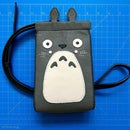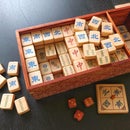Introduction: Cloak of Wings
Fly high with a handmade cloak of wings...
My username hints at my longtime desire to fly in the sky with my own pair of wings (ironically, I've never been on a plane before). I've finally done the next best thing: made my own cloak of wings! Pleather cutouts sandwich a layer of organza to generate the wings I've always wanted.
Today (September 15th) marks the third year of my instructables account, so a quick thank you to the instructables community: de-stressing through Instructables has been invaluable for my sanity throughout the ups and downs of college life. It's been a pleasure to share my ideas and receive feedback from everyone: thank you, thank you, thank you.
Step 1: Materials
- pleather or some sturdy, slightly thick fabric. I originally wanted to make the wings with some thick wool since I though the fluffiness might look interesting. However, pleather's much nicer for the wallet (and I was working at a sewing and design studio called Cut Sew Stitch in Claremont that happened to have rolls of pleather for projects).
- butcher paper rolls (for cutting out template)
- cardboard (to cut out feather templates)
- scrap fabric (and by scrap I mean cheap fabric for templates, not small pieces, so you can cut out patterns to test fit your cloak before designing feather patterns. I just used muslin)
- leather working glue (leather is resilient to most adhesives, so definitely use this for longer lasting adhesion)
- spray adhesive (temporarily bond paper to leather to get your templates to lay flat on your material as you cut it out)
- scissors (use good pairs to lessen the strain on your hand from cutting thick fabric)
- rotary fabric cutter (smaller diameter is better to reach into the sharp corners of the feathers)
- sewing machine (because hand sewing pleather is painful)
- walking foot (so your sewing machine can handle the pleather)
- thick needle (#18+ to go through your pleather)
Step 2: Shapes #1, #2: Cutting and Trimming Patterns on Paper
Shape #1 is the cloak part for your back, and shape #2 is the wingspan behind your arms. The parts at the top at your shoulders are curved so that the cloak has a little pocket where your shoulders will fit into, making the cloak hang off your shoulders comfortably.
Just freehand these rough, general shapes (1x shape #1, 1x shape #2 for now) on paper and cut them out, making sure that they're long enough to go down as much as you like. Keep in mind that you don't need to be perfect for this first cut! Overestimate so you can trim down later.
Once the paper is cut out, drape shape #2 over your arms. Make sure the beginning of the curved top region hits your shoulders, and that the end of shape #2 just hits your wrists (not too long, not too short -- up to your discretion). At this point it's a good idea to bring in a friend or two to comment on the shape: too long, too thin, not wing-like enough etc.?
Drape shape #1 over your back (with help from a friend) and make sure that it's wide enough to hit the tops of both of your shoulders and goes down as far as you'd like your wings to go. Trim the paper as you see fit.
Once both shapes are trimmed to your preferences, cut them out on fabric for testing (not pleather yet! just some cheap extra fabric you happen to have for pattern making). Go slowly when cutting on fabric. Also, remember to add ~0.5" seam allowance to the borders of your shapes: for shape #1 it's at the two long vertical edges (interfacing with shape #2) and for shape #2 it's the long vertical edge (interfacing with shape #1).
Step 3: Sewing Fabric and Testing the Fit
Assembly your fabric cut outs as shown in the first two pictures, making sure you use pins to properly line shapes up and keep them in place when sewing. You'll see that the two curved shoulder parts don't lie flat when sewn, since shape #2's curve has tighter curvature to fit over and sit on my shoulders comfortably. Then throw this over your shoulders and test it out!
Grab a friend again and ask them to critique away: do the shoulders look alright (hardest part), is the wing too long, etc. If possible, ask them to grab pins and try to fix what they see. Use marker to trace out new paths or curves that you should fix. For me, the shoulders were the main thing; I didn't want them to stick up so much, but they should still have a slight pocket to rest on my shoulders.
Once critiquing is over, remove the fabric from your shoulders and redo your stitching with the comments in mind. I had to rip the stitching and redo the shoulders, plus adjust how long the wings were. Once it's resewn, drape the fabric around your shoulders again and check for any additional adjustments. Repeat this process until you're happy with the fabric pattern.
Use this final fabric form (so yes, rip your sewing afterward) to adjust your paper patterns too -- you'll need this for tracing feathers in the next step.
Step 4: Adding Feather Shapes
Use some cardboard to sketch out some feather shapes (see first picture for some of mine). Make different sizes, shapes -- up to your preferences! I just wanted simple, hollow shapes with rounded tips but you can go for some variety. I only had four different sizes of the same basic shape, and that worked well enough for me.
Once you have as many different feathers as you'd like, tape together your paper shapes. Yes, as you can see in the second picture I taped up the 2x shape #2 at the edges. In hindsight I should have taped all the paper shapes as I wanted them on fabric (so shape #1 sandwiched by the two shape #2's) but I thought it'd be easier to see symmetry for the two main wings this way. In any case, arrange your feathers however you'd like and trace them to create your wing design, as seen in the third picture above. Do this for all three paper patterns, making sure that the edges' feathers go together (so when you sew the pleather together in the end, the feathers at the sewn interfaces make sense and go together -- that's why I say it makes sense to tape all three paper shapes together before drawing feathers).
Step 5: Cutting Out Pleather
To transfer your paper pattern to pleather, I lightly adhered my paper down on the pleather before cutting out the feather shapes that I traced out using a rotary cutter. For the spray adhesive, you don't want to use super glue. There are some specialized light glues designed for this purpose, so use those instead. Again, you'll need 1x shape #1, 2x shape #2 (but you need two mirror images of pleather for each, so that comes down to 2 total cutouts of shape #1 and 4 total cutouts of shape #2).
Since I need two of each paper pattern cut out (so I can glue two pieces of pleather shapes to sandwich organza in the end), I just put two layers of pleather right sides together before cutting the shapes. Go slowly with your rotary cutter to make sure you don't shift your layers when cutting and accidentally mess up anything. X-acto knives can be handy for some tight corners too. Be especially careful for cutting the edges, since these will be the most noticeable at the end.
Once all your pleather is cut, peel off the paper before it permanently bonds and leaves residues on your pleather.
Step 6: Gluing
Things got messy so I don't have pictures of this section (not going to risk my phone with sticky fingers, unfortunately..). But this part is fairly straightforward: sandwich your organza between the two pleather mirror images, glue them all together with strong leather working glue, and trim the organza excess when everything's dry. It gets messy because you inevitably get glue on your fingers, and you really need to be careful not to smear any on the pleather since it's hard to wipe off without residue trails. Do each of the three panels (1x shape #1, 2x shape #2) separately, and we'll sew them together in the next step.
Step 7: Sewing Panels Together
I also don't have pictures of these steps (sewing with one hand is pretty hard), but sewing was done on a sewing machine. To account for how thick the pleather is, you need to use a walking foot on your sewing machine and a thick needle #18+. Sew your two panels of shape #2 on either side of shape #1 just like you did with your fabric pattern earlier.
Sewing with pleather isn't too bad, but one key thing to note is that leather stretches. The foot of the sewing machine especially stretches it out with friction so just go slowly and keep the stretching minimal/as even as possible while feeding the pleather through.
A great tutorial for handling machine sewing leathers is here: I think it does a great job covering the basics for what you need to handle the sewing for this pleather project.
Step 8: Finished and Future Steps
Now you can flaunt your wings! You could also use the same technique for making a spider web cloak, and even add LED trimming to light up the night. It'd be especially interesting if you can hook up a micro controller to light up the cloak whenever you raise your arms -- the possibilities are endless.
As always, feel free to leave questions or comments below. Enjoy!






